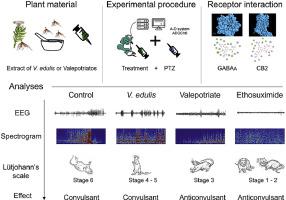Journal of Ethnopharmacology ( IF 4.8 ) Pub Date : 2020-08-22 , DOI: 10.1016/j.jep.2020.113299 María Eva González-Trujano 1 , Gerardo Contreras-Murillo 2 , Claudia Andrea López-Najera 2 , Fernando Josué Hidalgo-Flores 2 , Andrés Navarrete-Castro 3 , Concepción Gamboa Sánchez 1 , Víctor Manuel Magdaleno-Madrigal 2

|
Ethnopharmacological relevance
For many centuries, Mexican Valerian (Valeriana edulis ssp. procera) has been an important plant in folk medicine. It has been considered useful to control epilepsy; however, electroencephalographic evidence of its anticonvulsant activity is missing in literature.
Aim of the study: In the present study, in situ electroencephalographic (EEG) analysis was performed along with administration of a crude ethanol extract of V. edulis and its valepotriate fraction on the pentylenetetrazole (PTZ)-induced convulsive behavior in rats.
Materials and methods
Experiments were performed using male Wistar rats with nail-shaped electrodes implanted in the frontal and parietal cortices for EEG recording. All animals received a single dose of PTZ (35 mg/kg, i.p.) to test the anticonvulsant activity of V. edulis crude extract and valepotriate fraction (100 mg/kg, i.p.) 15 and/or 30 min after administration. EEG recordings were obtained from the cortices and were evaluated to assess ictal behavior over 60–75 min. Chromatographic analysis of the valepotriate fraction and in silico predictions of pharmacodynamic properties were also explored. The latency, frequency and duration of seizures evaluated using EEG recordings from the frontal and parietal cortices of rats showed significant changes demonstrating the inhibition of paroxystic activity.
Results
The spectral analysis confirmed the reduction of excitatory activity induced by V. edulis extract, which was improved in the presence of the valepotriate fraction as compared to that induced by ethosuximide (a reference anticonvulsant drug). The presence of valepotriates such as: isodihydrovaltrate (18.99%), homovaltrate (13.51%), 10-acetoxy-valtrathydrin (4%) and valtrate (1.34%) was identified by chromatographic analysis. Whereas, not only GABAA receptor participation but also the cannabinoid CB2 receptor was found to be likely involved in the anticonvulsant mechanism of action after in silico prediction.
Conclusions
Our data support the anticonvulsant properties attributed to this plant in folk medicine, due to the presence of valepotriates.
中文翻译:

缬草根和戊三酸酯对戊戊四唑诱发的大鼠癫痫发作的抗惊厥作用。
民族药理学意义
许多世纪以来,墨西哥缬草(缬草果亚种的Procera)一直在民间医学的一个重要工厂。人们认为控制癫痫病有用。然而,文献中缺少其抗惊厥活性的脑电图证据。
研究目的:在本研究中,进行了原位脑电图(EEG)分析,并给予了可食的V. edulis乙醇提取物及其戊三酸酯级分,对戊烯四唑(PTZ)诱导的大鼠惊厥行为。
材料和方法
实验是使用雄性Wistar大鼠进行的,该大鼠的指甲形电极植入额叶和顶叶皮层,用于记录脑电图。所有动物接受PTZ单剂量(35毫克/千克,腹膜内),以测试的抗惊厥活性V.贻贝粗提取物和级分valepotriate(100毫克/公斤,腹腔注射)15和/或给药后30分钟。从皮层获得脑电图记录,并对其进行评估以评估60-75分钟内的发作行为。还探讨了戊三酸酯级分的色谱分析和计算机模拟药效学预测。使用大鼠额叶和顶叶皮层脑电图记录的癫痫发作潜伏期,频率和持续时间,显示出明显的变化,证明了对阵发性活动的抑制。
结果
光谱分析证实了由V. edulis提取物引起的兴奋性活性的降低,与乙草胺(参考抗惊厥药)引起的相比,在戊三酸酯级分的存在下改善了。通过色谱分析鉴定了戊三酸酯的存在,例如:异二氢戊酸酯(18.99%),均戊酸酯(13.51%),10-乙酰氧基-戊醇(4%)和戊酸酯(1.34%)。然而,计算机模拟预测发现,不仅GABA A受体参与而且大麻素CB2受体也可能参与了抗惊厥作用机理。
结论
我们的数据支持了由于紫草酸的存在而使这种植物在民间医学中具有抗惊厥特性。






























 京公网安备 11010802027423号
京公网安备 11010802027423号